
Lingaraja Temple is a Hindu temple dedicated to Shiva and is one of the oldest temples in Bhubaneswar, the capital of the Indian state of Odisha, India. The temple is the most prominent landmark of Bhubaneswar city and one of the major tourist attractions of the state.Here also her consort is known as Parvati popularly called as Annapurna or Girija.
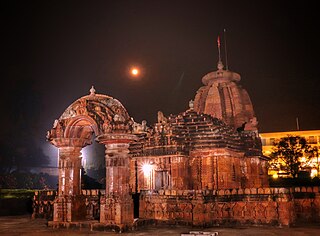
Mukteshwara Temple is a 10th-century Hindu temple dedicated to Shiva located in Bhubaneswar, Odisha, India. The temple dates back to 950–975 CE and is a monument of importance in the study of the development of Hindu temples in Odisha. The stylistic development the Mukteswara marks the culmination of all earlier developments, and initiates a period of experiment which continues for an entire century, as seen in such temples as the Rajarani Temple and Lingaraj temple, both located in Bhubaneswar. It is one of the prominent tourist attractions of the city.
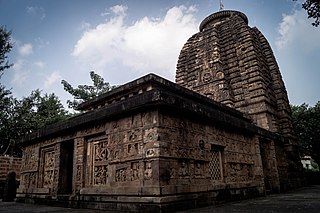
Parsurameswara Temple also spelt Parashurameshvara, located in the East Indian city of Bhubaneswar, the capital of Odisha, India, is considered the best preserved specimen of an early Odia Hindu temple dated to the Shailodbhava period between the 7th and 8th centuries CE. The temple is dedicated to the Hindu god Shiva and is one of the oldest existing temples in the state. It is believed to have been built around 650 CE in Nagara style and has all the main features of the pre-10th century Kalinga Architecture style temples. The temple is one among the Parashurameshvara group of temples.
Jalesvara Siva Temple Precinct is a Hindu Temple dedicated to Shiva situated on the southern outskirt of the village Kalarahanga at a distance of 2.00 km from Patia and 6.00 km south of Chudangagada in the northern outskirt of Bhubaneswar, Odisha, India. The presiding deity is a Siva-lingam within a circular yonipitha inside the sanctum, which is 1.15 meters below the chandrasila. The sanctum measures 2.00 square meters.
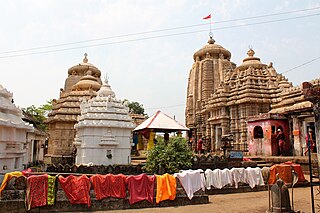
The Kapilesvara temple is a Hindu temple dedicated to Shiva located in the south western outskirt of the village Kapilesvara, Old Town, Bhubaneswar, Odisha, India. It is located at the end of Kapilesvara road leading from Lingaraj temple to Kapilesvara Village. The presiding deity is a Siva-lingam at the center of a circular yonipitha inside the sanctum. It is a living temple, facing towards east and maintained by Kapilesvara Temple Trust Board. The temple is situated within the precinct along with 33 other monuments. The precinct is located on the northern embankment of Manikarnika tank over an area of 44.00 square metres.

Lokanatha Siva Temple also Amunha Deula is an 11th-century AD temple in Bhubaneswar in the state of Odisha, India. It represents a proto type of Lingaraja in a miniature form. Lokanatha Siva temple is located in front of the Lingaraja temple in the south eastern corner across the road and adjacent to Lingaraja Temple Police Station in Old Town, Bhubaneswar. Until 1972 the temple was buried from all sides up to the bandhana portion, giving an impression as if the temple had no entrance. Hence people called it Amuha deula. In 1972 Debala Mitra conducted an excavation in front of the northern wall and exposed the entrance. The sanctum was empty. However, on the basis of the local traditions and the sculptural embellishment on the outer wall it was ascribed to Lord Siva. It is now known both as Lokanatha Siva and Amuha deula. People ascribe the temple to the Kesharis (Somavamsis). Except the entrance all other sides it is buried up to the bandhana.

Champakeswara Shiva Temple is located Ambika Sahi in the Old Town area of Bhubaneswar in Odisha, India. It is 157 metres west of Parasuramesvara on the right side of the Kotitirthesvara lane leading to Bindu sagara. It is a laterite temple. Local people believe that the enshrined Siva lingam is patalaphuta and the precinct is the abode of nagas after whom the deity is named as Champakesvara. The local people also believe that the temple precinct which is a den for the snakes do not harm any body.

Purvesvara Siva Temple is located in Kancha Sahi, in the Old Town of Bhubaneswar, Orissa, India. It was built in 13th century AD. It is a living temple and now under the care of Purvesvara Temple Development Association.
Markandesvara Siva Temple was constructed by Kesaris to commemorate the visit of sage Markandeya, same as the Samesvara Siva temple. It is an abandoned temple and is facing towards the east. However at the center of the sanctum there is a Siva-lingam with the circular Yoni pitha. The temple is totally covered with wild vegetations.
Nilakantha Siva temple is located in the Kharakhia Baidyanatha temple precinct, Kharakhia Vaidyanath Sahi, Old Town, Bhubaneswar. One can approach to this site on the left side of the Vaidyanath road leading from Lingaraja temple to Kapilesvara. This is a living temple and is facing towards the west. The enshrining deity of this temple is a Siva lingam within a circular yoni pitha at the centre of the sanctum sanatorium. The sanctum is 0.77 metres below the chandrasila.
The Somesvara Siva temple is located in the Kharakhia Baidyanath temple precinct in Kharakhia Vaidyanath Sahi, Old Town, of Bhubaneswar. It is located approximately 300 metres south of Lingaraja temple. Visitors may approach the site on the left side of Baidyanath Road leading from Lingaraja temple to Kapilesvar. It is a living temple and faces towards the west. The enshrined deity of this temple is a Siva lingam within a circular yonipitha at the center of the sanctuary located 0.93 metres below the chandrasila. The temple is under the care and maintenance of Babulal Makaddam Badu Mohapatra, the chief priest of the temple, on whose private land the temple stands.
Kartikesvara Siva Temple is situated at a distance of about 100 m from eastern gateway of Lingaraj temple. It is on the left side of the temple road leading from Lingaraja to Garej Chowk, Bhubaneswar, within the precinct of Gandhi Garabadu which is now under the Lingaraja Temple Administration.
Ladu Baba Temple is a temple in Bhubaneswar, Odisha, India. It was built in the 13th century AD and was formerly known as Kainchhi Temple.
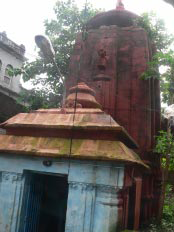
The Tirthesvara Siva temple is a Hindu template located in Bhubaneswar, the capital of Odisha, India.

Uttaresvara Siva Temple is a 12th-century Hindu temple dedicated to Lord Siva located in Bhubaneswar, Odisha, India.
Sukutesvara Temple located in the old town of bhubaneswar, Odisha,India,serves as purpose for community gathering. The preceding deity in this temple is a Siva- lingam situated at the centre. The temple observes various religious sacraments like Mahasivaratri, Chandipatha and Rudrabhisekha.

Astasambhu Siva Temples is a collection of 8 Hindu temples dedicated to Lord Siva located in Bhubaneswar, the capital of Odisha, India.
Chakresvara Shiva temple is a living Hindu temple built in 10-11 AD dedicated to Lord Shiva at Hatiasuni lane, Rajarani Colony, Bhubaneswar of Odisha, India. The deity, lingam, is in a circular yonipitha inside the sanctum. The temple is surrounded by private residential buildings on its eastern and northern side and chakresvara tank in the west. It is of great significance as rituals like Shivaratri, Diwali, and Sankranti are observed here. Also this temple serves as a purpose of a sacred place for 'Thread Ceremony, Rudrabhiseka, Chandrabhiseka.'
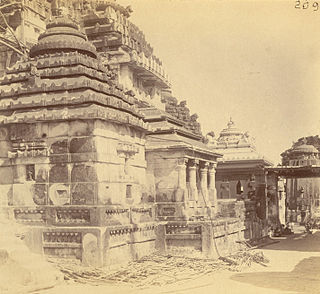
The Vimala Temple or Bimala Temple is a Hindu temple dedicated to goddess Vimala or Bimala (ବିମଳା), located within the Jagannath Temple complex in Puri in the Indian state of Odisha. It is generally regarded as a Shakta pitha, among the holiest temples dedicated to the Hindu Goddess.

Deula is an architectural element in a Hindu temple in the Kalinga architecture style of the Odishan temples in Eastern India. Sometimes the whole temple is also referred to as Deula. The word "deula" in Odia language means a building structure built with a particular style that is seen in most of the temples from Odisha. Deul is also used in English, though the deul temples are also of a different form in the Manbhum region of Western Bengal.

















